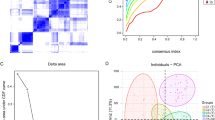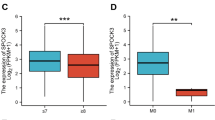Abstract
This study aimed to elucidate the role of anoikis in the progression of prostate cancer (PCa) and to develop a prognostic signature based on anoikis-related genes (ARGs). To achieve this, PCa cases were subjected to nonnegative matrix factorization (NMF) analysis, which allowed for the identification of distinct patterns of anoikis modification. Additionally, immune infiltration was evaluated using single-sample gene-set enrichment analysis (ssGSEA). Survival analysis was performed using the Kaplan-Meier method, and a risk score was generated based on the expression levels of ARGs to quantitatively assess the modification of anoikis in PCa. Using the Least Absolute Shrinkage and Selection Operator (LASSO) method, four hub-genes were identified, and patients were classified into different risk groups based on their individual scores. Importantly, the low-risk subtype was characterized by a significantly improved biochemical recurrence-free survival, underscoring the clinical relevance of the ARG-based prognostic signature. To further improve the prognostic accuracy of the signature, patient age, pathological T stage, Gleason score, and prostate-specific antigen level were incorporated into the analysis, yielding a comprehensive prognostic signature. The clinical relevance of this signature was illustrated through a nomogram, providing a visual representation of the prognostic implications of the ARG-based signature. Taken together, these findings highlight the potential of ARGs in predicting the clinical outcomes of PCa patients and provide a novel and clinically relevant prognostic signature based on the modification of anoikis in PCa.







Similar content being viewed by others
Data Availability
All data in our research can be acquired from TCGA datasets (https://portal.gdc.cancer.gov/) and GEO datasets (https://www.ncbi.nlm.nih.gov/gds/).
References:
Adeshakin FO, Adeshakin AO, Afolabi LO, Yan D, Zhang G, Wan X (2021) Mechanisms for modulating anoikis resistance in cancer and the relevance of metabolic reprogramming. Front Oncol 11:626577
Alanko J, Mai A, Jacquemet G et al (2015) Integrin endosomal signalling suppresses anoikis. Nat Cell Biol 17(11):1412–1421
Alfano A, Xu J, Yang X, Deshmukh D, Qiu Y (2022) SRC kinase-mediated tyrosine phosphorylation of TUBB3 regulates its stability and mitotic spindle dynamics in prostate cancer cells. Pharmaceutics 14(5):932
Blanche P, Dartigues JF, Jacqmin-Gadda H (2013) Estimating and comparing time-dependent areas under receiver operating characteristic curves for censored event times with competing risks. Stat Med 32(30):5381–5397
Buchheit CL, Weigel KJ, Schafer ZT (2014) Cancer cell survival during detachment from the ECM: multiple barriers to tumour progression. Nat Rev Cancer 14(9):632–641
Califice S, Castronovo V, Van Den Brûle F (2004) Galectin-3 and cancer (Review). Int J Oncol 25(4):983–992
Cao L, Zhang Z, Han L et al (2014) Mitogen-activated protein kinase pathway is pivotal for anoikis resistance in metastatic hepatoma cells. Mol Med Rep 9(4):1121–1127
Cao Z, Livas T, Kyprianou N (2016) Anoikis and EMT: lethal “liaisons” during cancer progression. Crit Rev Oncog 21(3–4):155–168
Carlsson SV, Vickers AJ (2020) Screening for prostate cancer. Med Clin North Am 104(6):1051–1062
Cha HR, Lee JH, Ponnazhagan S (2020) Revisiting immunotherapy: a focus on prostate cancer. Cancer Res 80(8):1615–1623
Chang CC, Yang MH, Lin BR et al (2013) CCN2 inhibits lung cancer metastasis through promoting DAPK-dependent anoikis and inducing EGFR degradation. Cell Death Differ 20(3):443–455
Charoentong P, Finotello F, Angelova M et al (2017) Pan-cancer immunogenomic analyses reveal genotype-immunophenotype relationships and predictors of response to checkpoint blockade. Cell Rep 18(1):248–262
Chen S, Zhu G, Yang Y et al (2021) Single-cell analysis reveals transcriptomic remodellings in distinct cell types that contribute to human prostate cancer progression. Nat Cell Biol 23(1):87–98
Chiarugi P, Giannoni E (2008) Anoikis: a necessary death program for anchorage-dependent cells. Biochem Pharmacol 76(11):1352–1364
Das DK, Ogunwobi OO (2017) A novel microRNA-1207-3p/FNDC1/FN1/AR regulatory pathway in prostate cancer. RNA Dis 4(1):e1503
Dawid IB, Breen JJ, Toyama R (1998) LIM domains: multiple roles as adapters and functional modifiers in protein interactions. Trends Genet 14(4):156–162
Dondoo TO, Fukumori T, Daizumoto K et al (2017) Galectin-3 is implicated in tumor progression and resistance to anti-androgen drug through regulation of androgen receptor signaling in prostate cancer. Anticancer Res 37(1):125–134
Egevad L, Valdman A, Wiklund NP, Sève P, Dumontet C (2010) Beta-tubulin III expression in prostate cancer. Scand J Urol Nephrol 44(6):371–377
Erdogan B, Ao M, White LM et al (2017) Cancer-associated fibroblasts promote directional cancer cell migration by aligning fibronectin. J Cell Biol 216(11):3799–3816
Frisch SM, Schaller M, Cieply B (2013) Mechanisms that link the oncogenic epithelial-mesenchymal transition to suppression of anoikis. J Cell Sci 126(Pt 1):21–29
Gilmore AP (2005) Anoikis. Cell Death Differ 12(Suppl 2):1473–1477
Hänzelmann S, Castelo R, Guinney J (2013) GSVA: gene set variation analysis for microarray and RNA-seq data. BMC Bioinformatics 14:7
Hazra A, Gogtay N (2016) Biostatistics series module 3: comparing groups: numerical variables. Indian J Dermatol 61(3):251–260
Howe EN, Cochrane DR, Cittelly DM, Richer JK (2012) miR-200c targets a NF-κB up-regulated TrkB/NTF3 autocrine signaling loop to enhance anoikis sensitivity in triple negative breast cancer. PLoS ONE 7(11):e49987
Huan Y, Wu D, Zhou D, Sun B, Li G (2015) DBC1 promotes anoikis resistance of gastric cancer cells by regulating NF-κB activity. Oncol Rep 34(2):843–849
Janković MM, Kosanović MM (2008) Fibronectin pattern in benign hyperplasia and cancer of the prostate. Dis Markers 25(1):49–58
Kgatle MM, Boshomane TMG, Lawal IO et al (2021) Immune checkpoints, inhibitors and radionuclides in prostate cancer: promising combinatorial therapy approach. Int J Mol Sci. https://doi.org/10.3390/ijms22084109
Knapp JS, Lokeshwar SD, Vogel U et al (2013) Galectin-3 expression in prostate cancer and benign prostate tissues: correlation with biochemical recurrence. World J Urol 31(2):351–358
Kwon JTW, Bryant RJ, Parkes EE (2021) The tumor microenvironment and immune responses in prostate cancer patients. Endocr Relat Cancer 28(8):T95-t107
Lee Y, Yoon J, Ko D, Yu M, Lee S, Kim S (2021) TMPRSS4 promotes cancer stem-like properties in prostate cancer cells through upregulation of SOX2 by SLUG and TWIST1. J Exp Clin Cancer Res 40(1):372
Liberzon A, Birger C, Thorvaldsdóttir H, Ghandi M, Mesirov JP, Tamayo P (2015) The molecular signatures database (MSigDB) hallmark gene set collection. Cell Syst 1(6):417–425
Matthews JM, Lester K, Joseph S, Curtis DJ (2013) LIM-domain-only proteins in cancer. Nat Rev Cancer 13(2):111–122
Meng J, Zhou Y, Lu X et al (2021) Immune response drives outcomes in prostate cancer: implications for immunotherapy. Mol Oncol 15(5):1358–1375
Mo CF, Li J, Yang SX et al (2020) IQGAP1 promotes anoikis resistance and metastasis through Rac1-dependent ROS accumulation and activation of Src/FAK signalling in hepatocellular carcinoma. Br J Cancer 123(7):1154–1163
Nahand JS, Khanaliha K, Mirzaei H et al (2021) Possible role of HPV/EBV coinfection in anoikis resistance and development in prostate cancer. BMC Cancer 21(1):926
Nakajima K, Heilbrun LK, Hogan V, Smith D, Heath E, Raz A (2016) Positive associations between galectin-3 and PSA levels in prostate cancer patients: a prospective clinical study-I. Oncotarget 7(50):82266–82272
Newman AM, Liu CL, Green MR et al (2015) Robust enumeration of cell subsets from tissue expression profiles. Nat Methods 12(5):453–457
Nguyen-Nielsen M, Borre M (2016) Diagnostic and therapeutic strategies for prostate cancer. Semin Nucl Med 46(6):484–490
Ong CW, Maxwell P, Alvi MA et al (2018) A gene signature associated with PTEN activation defines good prognosis intermediate risk prostate cancer cases. J Pathol Clin Res 4(2):103–113
Pan J, Gillis N (2021) Generalized separable nonnegative matrix factorization. IEEE Trans Pattern Anal Mach Intell 43(5):1546–1561
Paoli P, Giannoni E, Chiarugi P (2013) Anoikis molecular pathways and its role in cancer progression. Biochim Biophys Acta 1833(12):3481–3498
Park SH, Riley PT, Frisch SM (2013) Regulation of anoikis by deleted in breast cancer-1 (DBC1) through NF-κB. Apoptosis 18(8):949–962
Penney KL, Sinnott JA, Fall K et al (2011) mRNA expression signature of Gleason grade predicts lethal prostate cancer. J Clin Oncol 29(17):2391–2396
Powers RK, Goodspeed A, Pielke-Lombardo H, Tan AC, Costello JC (2018) GSEA-InContext: identifying novel and common patterns in expression experiments. Bioinformatics 34(13):i555–i564
Ramachandra M, Atencio I, Rahman A et al (2002) Restoration of transforming growth factor Beta signaling by functional expression of smad4 induces anoikis. Cancer Res 62(21):6045–6051
Rebello RJ, Oing C, Knudsen KE et al (2021) Prostate Cancer. Nat Rev Dis Primers 7(1):9
Rennebeck G, Martelli M, Kyprianou N (2005) Anoikis and survival connections in the tumor microenvironment: is there a role in prostate cancer metastasis? Cancer Res 65(24):11230–11235
Ritchie ME, Phipson B, Wu D et al (2015) limma powers differential expression analyses for RNA-sequencing and microarray studies. Nucleic Acids Res 43(7):e47
Sathianathen NJ, Konety BR, Crook J, Saad F, Lawrentschuk N (2018) Landmarks in prostate cancer. Nat Rev Urol 15(10):627–642
Sinnott JA, Peisch SF, Tyekucheva S et al (2017) Prognostic utility of a new mRNA expression signature of gleason score. Clin Cancer Res 23(1):81–87
Sun D, Wang J, Han Y et al (2021) TISCH: a comprehensive web resource enabling interactive single-cell transcriptome visualization of tumor microenvironment. Nucleic Acids Res 49(D1):D1420-d1430
Taddei ML, Giannoni E, Fiaschi T, Chiarugi P (2012) Anoikis: an emerging hallmark in health and diseases. J Pathol 226(2):380–393
Tajbakhsh A, Rivandi M, Abedini S, Pasdar A, Sahebkar A (2019) Regulators and mechanisms of anoikis in triple-negative breast cancer (TNBC): a review. Crit Rev Oncol Hematol 140:17–27
Walden PD, Globina Y, Nieder A (2004) Induction of anoikis by doxazosin in prostate cancer cells is associated with activation of caspase-3 and a reduction of focal adhesion kinase. Urol Res 32(4):261–265
Wang G, Zhao D, Spring DJ, Depinho RA (2018a) Genetics and biology of prostate cancer. Genes Dev 32(17–18):1105–1140
Wang YN, Zeng ZL, Lu J et al (2018b) CPT1A-mediated fatty acid oxidation promotes colorectal cancer cell metastasis by inhibiting anoikis. Oncogene 37(46):6025–6040
Wilkerson MD, Hayes DN (2010) ConsensusClusterPlus: a class discovery tool with confidence assessments and item tracking. Bioinformatics 26(12):1572–1573
Xu W, Sun T, Wang J et al (2022) LMO3 downregulation in PCa: a prospective biomarker associated with immune infiltration. Front Genet 13:945151
Yang F, Zeng Q, Yu G, Li S, Wang CY (2006) Wnt/beta-catenin signaling inhibits death receptor-mediated apoptosis and promotes invasive growth of HNSCC. Cell Signal 18(5):679–687
Ye G, Yang Q, Lei X et al (2020) Nuclear MYH9-induced CTNNB1 transcription, targeted by staurosporin, promotes gastric cancer cell anoikis resistance and metastasis. Theranostics 10(17):7545–7560
Yin Y, Zhang Q, Zhang H, He Y, Huang J (2017) Molecular signature to risk-stratify prostate cancer of intermediate risk. Clin Cancer Res 23(1):6–8
Acknowledgements
All authors contributed to the article and approved the submitted version. There was no third party support in conducting this research, analyzing the data, or preparing the manuscript for submission.
Funding
This study was supported by the Natural Science Foundation of Fujian Province [Grant number 2020J011220 and 2020J011236], the Key Medical and Health Projects in Xiamen (Grant number 3502Z20209002) and the National Natural Science Foundation of China [Grant number 81772893]. The authors declare no conflicts of interests.
Author information
Authors and Affiliations
Contributions
CY conceived the idea. CY and TY designed the study. CY collected the data, finished the content analysis, and edited the article pictures. TY and QWL helped editing the article pictures. CY drafted the manuscript. TY and QL reviewed and corrected the manuscript.
Corresponding author
Ethics declarations
Competing Interest
The authors declare no competing interests.
Ethical Approval
All data in our research were acquired from public datasets and did not require ethical review.
Consent to Participate
All data in our research were acquired from public datasets and did not require informed consent.
Consent for Publication
All authors have given their consent for publication.
Additional information
Publisher's Note
Springer Nature remains neutral with regard to jurisdictional claims in published maps and institutional affiliations.
Rights and permissions
Springer Nature or its licensor (e.g. a society or other partner) holds exclusive rights to this article under a publishing agreement with the author(s) or other rightsholder(s); author self-archiving of the accepted manuscript version of this article is solely governed by the terms of such publishing agreement and applicable law.
About this article
Cite this article
Yang, C., Yu, T. & Lin, Q. A Novel Signature Based on Anoikis Associated with BCR-Free Survival for Prostate Cancer. Biochem Genet 61, 2496–2513 (2023). https://doi.org/10.1007/s10528-023-10387-9
Received:
Accepted:
Published:
Issue Date:
DOI: https://doi.org/10.1007/s10528-023-10387-9




